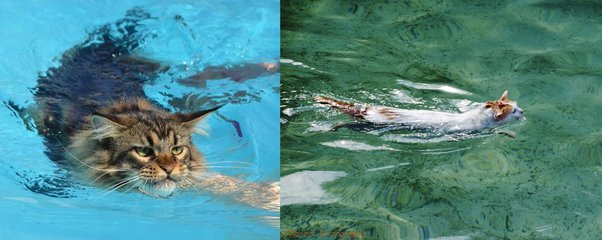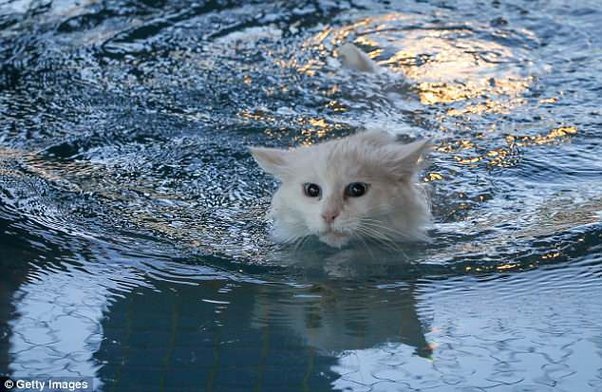Ahoy, cat lovers! Today, we’re diving into the wet and wild world of cats and swimming. You might be wondering, “Can a cat swim?” Well, I’m here to unravel this intriguing whisker mystery. We’ll explore everything from cats’ natural body of water abilities to why some kinds of cats hate water. As a cat owner or someone considering adopting a feline friend, it’s crucial to understand our furry companions’ behavior and needs.
Table of Contents
Are Cats Natural Swimmers?
Believe it or not, cats can swim! Most domestic cats have an inherent ability to swim. However, not all cats are thrilled about taking a dip.
Maine Coon: Nature’s Aquatic Marvel
Maine Coons are not only loved for their majestic looks but also for their particular interest in water. With their dense, water-resistant fur and large paws, they are built for swimming. It is believed that they developed these traits from their ancestors, who were shipcats responsible for catching mice on ships during long voyages. However, while many Maine Coons are fond of water, it’s essential to remember that each cat has its preferences. If you’re lucky enough to have a Maine Coon who loves water, consider yourself captain of a very exclusive ship!
Turkish Van: The Legendary Aquanaut
Originating in the Lake Van region of Turkey, the Van cat has been dubbed the ‘swimming cat.’ This cat doesn’t just paddle; it can swim! Legends say that Van cats enjoyed swimming and swam through Lake Van for centuries. This breed has a unique cashmere-like coat that is water-resistant. But don’t rush to put your Van cat in water; always ensure they’re comfortable and happy to participate.
Turkish Angora: The Unexpected Enthusiast
Like the Van cats, the Turkish Angora is another breed that doesn’t mind getting wet. Though not as famous for their swimming skills, some Turkish Angoras have been known to splash around happily.
Bengal: The Playful Paddler
Bengals are known for their playful nature, which sometimes extends to water play. Don’t be surprised if your Bengal cat, also known as a tiger, tries to join you in the bathtub!

Cats and Water: The Love-Hate Relationship
We’ve established that cats can swim, but many cats despise water. But what about the exceptions?
Why do Cats Hate Water?
Since every cat is different, many cats exhibit a strong aversion to water. Here are several reasons why this aversion exists:
- Evolutionary Background: Cats are descendants of desert-dwelling wildcats, and their ancestors did not frequently encounter large bodies of water. This lack of exposure to water in their evolutionary history contributes to the natural aversion many house cats have.
- Fur and Skin Sensitivity: Cats have dense fur and a unique fur structure that helps keep them dry. When their fur gets wet, it becomes heavy and makes them uncomfortable. Additionally, a cat’s skin is more sensitive than other animals, making wet fur cling to their bodies and creating a sensation they dislike.
- Lack of Control: Cats are known for their strong sense of independence and control. Being in water can make them feel vulnerable and out of control, which goes against their instinctual behavior.
- Grooming Habits: Cats are meticulous groomers, and their grooming routine helps keep their fur clean and dry. Being forced into water disrupts this natural behavior, leading to stress and discomfort.
- Smell and Taste: Cats have a highly developed sense of smell, and wet fur can change their scent. This alteration in scent might be distressing for them. Additionally, the taste of water on their fur can be unpleasant.
- Temperature Sensitivity: Cats are sensitive to temperature changes, and being wet can make them feel cold. This discomfort can intensify their aversion to water.
- Adverse Experiences: If a cat has had a negative experience with water, such as being forcefully given a bath, they may associate water with stress and fear, leading to a lasting aversion.
Despite their general dislike for water, there are exceptions. Some cats may be more tolerant of water if introduced gradually and positively. Additionally, certain breeds of cats, like the Turkish Van, are known for their love of water.
Preparing for the First Swim of Your Cat
Should you find your cat showing an affinity for water, here are some steps to ensure a smooth sailing first swim:
Step 1: Vet Check
Before you even think about making waves with your whiskered friend, ensuring they’re a ship-shape for the adventure is vital. Please consult your veterinarian to confirm that your cat is in good health and that swimming suits them. Some cats may have underlying health issues that could be aggravated by water exposure.
Step 2: Gather Supplies
Just as a captain needs a compass, your cat needs the right gear:
- Slip-resistant mat: Place this in the tub or pool area to prevent slipping.
- Soft towel: Have this ready for drying your cat post-swim.
- Cat-friendly shampoo: In case you want to bathe them during the process.
- Treats: Essential for positive reinforcement.
- Floating toys: To keep them engaged and associate water with fun.
- Life jacket (for larger pools): Safety is essential!
Step 3: Choose the Right Environment
The setting can make or break your cat’s first swimming experience. Select a quiet, enclosed space free from distractions. Warm water is a must – cats detest being cold! A bathroom or a kiddie pool in a quiet area is ideal. Ensure there are no harmful chemicals in the water.
Step 4: Slow and Steady
Remember the old saying, “You can lead a horse to water, but you can’t make it drink”? This applies to cats and swimming. Slowly ease your cat into the water and let them take it at their own pace. Start by letting them wet their paws and gradually increase as they become comfortable. Never, ever force them.
Step 5: Post-Swim Care
Once your cat knows how to swim, it’s time for some TLC. Dry them thoroughly with a soft towel, and keep them warm. Give them lots of praise and some of those treats you’ve got ready. Check for any signs of irritation or discomfort after the swim.

The Science Behind Cats and Water
Let’s take a deep dive into the science behind why most cats aren’t fans of water:
The Smell Factor
Cats have an extraordinarily developed sense of smell, about 14 times stronger than humans. Chlorine and other chemicals typically found in water may be highly off-putting to them. It’s not just the smell of the chemicals; it’s also the fact that water washes away the natural scents on their fur that they use for comfort and marking territory.
Weight of Wet Fur
Cats are the ninjas of the animal world – built for stealth, agility, and speed. Wet fur becomes heavy and can impede their movements, which is quite uncomfortable and unsettling for many cats.
The Bond Between Cats and Humans Through Swimming
Taking the plunge with your cat isn’t just about them getting exercise; it can also be a fantastic bonding activity. When done right, it can help build trust, and let’s not forget – it’s quite the experience to have! Seeing your feline paddling around can be a memory you’ll cherish forever. Plus, your cat will associate the positive experience with you, which can strengthen your bond.
Make sure that swimming remains a positive and rewarding experience for your whiskered friend, and don’t forget to capture these precious moments (make sure your camera is waterproof!).
Now, anchors aweigh, my feline-loving friends! May your sailing be smooth and your waters always warm. Also, if you want more tips and guides regarding your cats, check out our blog.
Frequently Asked Questions
Q: Can all cats swim?
A: No, not all cats can swim. While some breeds of cats enjoy swimming and are natural aquanauts, others may be afraid of water or dislike it.
Q: Do cats enjoy being in the water?
A: Some cats enjoy water, especially certain breeds such as the Turkish Van and the Bengal. However, it ultimately depends on the cat’s personality and experiences with water.
Q: Can you train your cat to swim?
A: It is possible to train your cat to swim, but it’s essential to approach it cautiously and ensure it feels comfortable and safe in the water. Not all cats will take to swimming, even with training.
Q: Do domestic cat breeds have a natural affinity for water?
A: While domestic cat breeds vary in their affinity for water, some naturally swim and enjoy water activities, whereas others may avoid water altogether.
Q: Can big cats, like tigers and lions, swim?
A: Yes, big cats such as tigers and lions are capable swimmers and are often seen enjoying the water, whether for play, hunting, or cooling off.
Q: What should I do if my cat seems afraid of water?
A: If your cat appears to be apprehensive about water, it’s best not to force them into situations they are uncomfortable with. Instead, gradually introduce them to water and observe their reactions, always prioritizing their comfort and safety.
Q: Are there any health benefits to allowing a cat to swim?
A: While swimming is not necessary for most cats, water can help regulate body temperature and provide low-impact exercise. However, not all cats will enjoy these benefits, and it’s essential always to consider the individual cat’s preferences and needs.
Q: Should I be concerned if my cat accidentally falls into a swimming pool?
A: If your cat has fallen into a swimming pool, ensuring they are safe and unharmed is crucial. Additionally, it’s essential to monitor them for any signs of distress or potential health issues resulting from the incident.
Q: Are there any cat breeds known for their avoidance of water?
A: While some cat breeds may enjoy the water, others, such as the Siamese and the Persian, are often known for avoiding water and general disinterest in swimming or aquatic environments.
Q: How can I introduce my cat to water positively?
A: To help your cat feel more comfortable around water, consider gradually introducing them to it using a shallow container or a kiddie pool. Always prioritize positive experiences and avoid forcing your cat into any situation that may cause undue stress or fear.